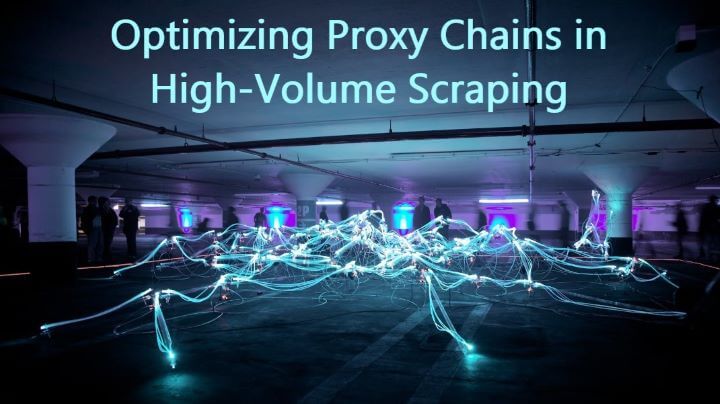Advanced Techniques for Optimizing Proxy Chains in High-Volume Scraping

In the digital landscape, the task of extracting valuable data without getting blocked or detected can seem impossible. But what if I told you there are easy ways to navigate this maze? That’s right, the power to master high-volume web scraping using proxy chains is within your grasp. You will learn all about it from my definitive guide. After reading it, you’ll be able to manage ANY web scraping project efficiently.
Understanding Proxy Chains
If you are making your first steps in high-volume web scraping, it’s crucial to first grasp the concept of proxy chains. These are a meticulously crafted sequence that forms the backbone of stealthy data extraction.
In a nutshell, these chains refer to a series of proxy servers linked together. When you send a request to a website, it travels through this chain before reaching the site. Each actor in the chain forwards your request to the next, effectively masking your original IP address and location at each step. So, the core advantages of this would be:
- anonymity
- security
- flexibility.
Understanding the nuances of these chains is the first step in mastering high-volume web scraping. As we move forward, I’ll explain why they are essential in scraping as well as how to set them up.
Want to learn more about proxy chains? Read my article where I explain in detail the proxy chain mechanism and usage.
Why Use Proxy Chains in Scraping?

Using proxy chains is a strategic move that can significantly elevate the effectiveness of your data collection efforts. Let’s now discuss the nuanced benefits that they bring to the table.
Enhanced Anonymity
Such chains add multiple layers of IP addresses between you and the target website. This complexity makes it exponentially more difficult for the website to trace the origin of the request back to your actual IP address.
Thus, each proxy in the chain contributes to a more intricate digital footprint. Thanks to this, your scraping activities are effectively disguised in the vast expanse of internet traffic.
Robust IP Ban Avoidance
Continuous IP rotation helps chains minimize the risk of any single proxy being detected and banned. It ensures a consistently fresh face to the target website, preserving uninterrupted access.
Besides, advanced chains can intelligently distribute requests based on the health and performance of each intermediary. This further reduces the likelihood of triggering anti-scraping measures.
Geo-Targeting
Chains can include proxies from various geographical locations. This gives you access to region-specific data that might be inaccessible due to geo-restrictions.
By strategically selecting servers in specific regions, you can tailor your scraping activities effectively. This means your activities appear as though they originate from within those regions, which unlocks a wealth of localized information.
Setting Up Proxy Chains: 3 Core Steps
Step #1: Select Proxy Types
When constructing your chain, I’d recommend using a blend of residential, data center, and mobile proxies to create a diverse and resilient pool. If you consider using one particular type, make sure you understand how it fits your goals:
- Residential: Ideal for high anonymity due to their association with real IP addresses. They are less likely to be flagged but generally offer slower speeds.
- Datacenter: Known for their high speed and efficiency, these are perfect for tasks requiring fast response times. However, they might be more prone to detection and blocking.
- Mobile: These are linked to mobile devices which makes them highly effective for tasks that require a high level of trust and lower block rates.
Step #2: Proxy Rotation Logic
Intelligent rotation is key to avoiding detection. Here are three core factors I usually consider:
- Request rate: Adjust the rotation frequency based on your request volume. High-volume scraping might require more frequent rotation.
- Website sensitivity: Some websites have sophisticated anti-scraping measures. For these, use a more diverse pool and rotate more frequently.
- Proxy performance: Monitor and rotate out proxies that show signs of slowing down or being blocked.
Step #3: Geo-Diversity
For scraping geo-specific data, the geographical diversity of your pool is vital. Ensure that your proxies span multiple regions and countries to access localized content and avoid geo-blocks.
Advanced Configuration Techniques

Load Balancing
The goal of load balancing is to distribute web scraping requests across your pool. Each proxy will thus carry a balanced load preventing any single one from becoming overburdened and easily detectable. Let’s take a closer look at how you can achieve that.
- Dynamic Request Allocation
Implement algorithms that dynamically allocate requests based on current performance. This ensures that a temporarily slow or busy intermediary doesn’t become a bottleneck.
- Regular Proxy Health Checks
Integrate a system for continuous monitoring of proxy health. If a server consistently shows high latency or errors, it should be temporarily sidelined or replaced.
- Weighted Distribution Tactics
Assign more requests to your most reliable and fastest proxies, but don’t neglect the slower ones. This weighted distribution helps to maintain a natural-looking traffic pattern (and avoid detection in the long run).
Session Management
When scraping websites that require logged-in sessions or tracking user interactions, you should pay special attention to maintaining integrity. This is where sticky sessions come into play. Their role is to ensure that a series of requests from your scraper maintains the same IP address during the session. Here are a few important considerations in this regard.
- Intelligent Sticky Session Configuration
Develop a system where each session is assigned to a specific proxy. The latter will handle all requests for that session. This way, you’ll maintain consistency and reduce the risk of triggering security alarms on the target website.
- Balancing Session Duration
It’s a delicate balance. Too short, and you might not complete your task. Too long, and you risk detection. Implement logic that controls the duration of each session based on the website’s sensitivity and typical user behavior.
- Periodic Session Rotation
To further mask your scraping activities, rotate the proxies assigned to specific sessions at regular intervals. This mimics the behavior of a regular user who might use different devices or networks over time.
Adaptive Timing
One of the biggest giveaways of automated scraping is the timing of requests. Websites can easily flag non-human patterns, such as constant intervals between requests. To counter this, adaptive timing is essential, and here are a few tips on how you could achieve that.
- Implementing Randomized Delays
Introduce random delays between requests. These should not follow any predictable pattern and should vary in length. The key task here is to mimic the irregular browsing speed of a human user.
- Mimicking Behavioral Patterns
Analyze typical user behavior on the target site and adjust your request intervals accordingly. For instance, after a burst of rapid requests, introduce a longer pause, as a real user might do when reading content.
- Smart Rate Limiting
Set thresholds for the number of requests sent within a specific timeframe. This rate limiting should be flexible, adjusting to different times of day or different target sites. It is important to maintain a non-aggressive, human-like request pattern.
Proxy Chain Optimization
Performance Monitoring
In optimizing your proxy chain, the key lies in a nuanced approach to performance monitoring. It’s not just about tracking response times or success rates as many think. It’s about understanding the complex dynamics between different proxies and how they interact with target websites.
For instance, I’ve found that analyzing the variance in response times over different periods can reveal patterns in website behavior, allowing for more strategic IP rotation. This approach helps in preemptively identifying proxies that might soon be flagged or throttled by websites.
How to check proxy performance? Read my comprehensive guide on proxy performance metrics and how to measure them.
Proactive Proxy Management
Effective proxy management involves a predictive strategy, where you anticipate performance issues and adapt your server configuration accordingly. For example, by analyzing historical data, you can identify proxies that are likely to be blocked during peak hours on certain websites and rotate them out of your chain preemptively. This keeps your IP pool fresh and reduces the risk of encountering blocks or CAPTCHAs.
Besides, customizing performance metrics specific to your scraping objectives allows for a more tailored assessment of proxy effectiveness. For instance, if scraping speed is a priority, prioritizing metrics like time-to-first-byte can be more insightful than just looking at overall success rates.
Balancing Blacklist Management with Scalability
Managing blacklists effectively while ensuring scalability is a delicate balance. Advanced techniques, such as employing machine learning algorithms, can predict which proxies are at risk of being blacklisted based on their usage patterns.
On the scalability front, it’s crucial to focus on an infrastructure that can dynamically adjust to your needs. Thus, implementing a cloud-based proxy management system can offer the flexibility to scale up or down quickly, depending on your scraping demands.
Navigating CAPTCHAs and Blocks with Advanced Techniques
My experience has shown that integrating CAPTCHA-solving services is, first and foremost, about selecting a solution that aligns with the complexity and frequency of CAPTCHAs you encounter. For instance, for simple image-based CAPTCHAs, basic OCR (Optical Character Recognition) solutions might suffice. For more complex CAPTCHAs like reCAPTCHA, advanced AI-based solvers are necessary. Your selection greatly impacts the efficiency of your scraping operation.
When it comes to fallback strategies, the key is in their dynamic application. Simply switching to a different proxy upon encountering a block can be effective, but it’s often a short-term solution. A more nuanced approach involves analyzing the type of block or CAPTCHA encountered. If a block is due to rate limiting, slowing down the request rate or changing the user agent can be more effective than just switching proxies.
Security and Compliance in Web Scraping
For many, security and compliance in web scraping are just checkboxes but I wouldn’t underestimate their importance. The use of HTTPS proxies is a basic yet crucial step if you want to ensure encrypted connections. And always strive to understand the security protocols of the proxies themselves. It’s essential to choose ones that offer robust encryption and security features to protect your data from potential vulnerabilities.
Bonus: Best Practices for Proxy Chain Mastery
On balance, if you want to succeed in web scraping, you must develop a mindset of continuous improvement and adaptability. As a bonus, I’d love to summarize some refined strategies and insights that I’ve developed over years of experience.
- Regular Updates
Keeping your proxy list and scraping scripts up-to-date is crucial and it’s not mere routine maintenance I’m talking about. For instance, if you want to keep your proxy list updated, don’t just replace non-functional proxies and that’s it.
Analyze trends and preemptively refresh your pool with proxies suited to current web dynamics. Similarly, updating scraping scripts involves not only fixing bugs but also adapting to changes in website structures and anti-scraping technologies.
- Testing and Validation
Regular testing of your proxy chain setup is essential, but it should go beyond basic functionality checks. Conduct thorough performance evaluations under various conditions.
For example, stress-testing your proxy chain under high-load scenarios can reveal potential bottlenecks or weaknesses in your setup. Or, implementing automated testing scripts that simulate real-world scraping tasks can provide deep insights into the robustness and reliability of your chain.
- Comprehensive Documentation
Maintaining detailed documentation of your configurations, changes, and updates is invaluable for scaling your operations. This documentation should include technical details and rationales behind each configuration choice.
Documenting the performance impact of different proxy configurations can guide future optimization efforts. Likewise, maintaining a change log can be incredibly helpful in understanding the evolution of your scraping setup.
Final Words
Optimizing proxy chains for high-volume scraping is a dynamic and challenging task. But you now know the advanced techniques that can help you significantly enhance your scraping efficiency, maintain anonymity, and reduce the risk of detection and blocking. Remember, the key to successful scraping lies in the intelligent and ethical use of technology!
